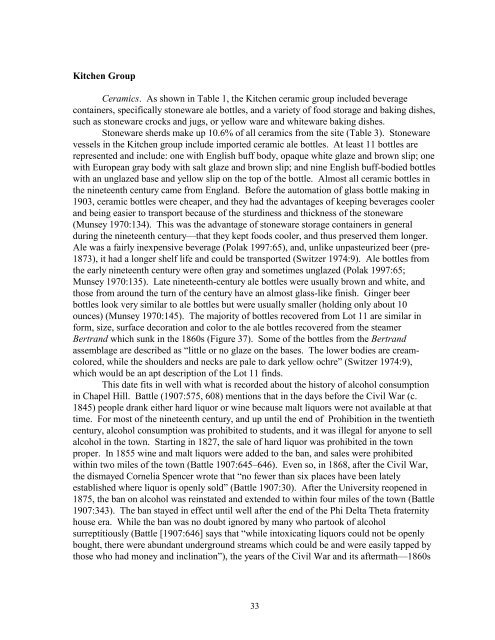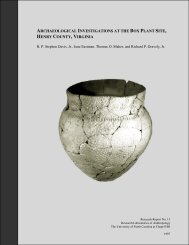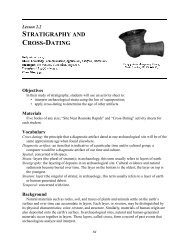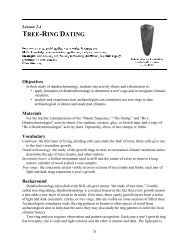The numbers listed on the table <strong>of</strong> functional artifact classes (Table 1) are small forthe Kitchen and Dining groups, because function could not be determined for the majority <strong>of</strong>ceramic, glass, and metal artifacts. Table 3, a summary <strong>of</strong> ceramic artifacts by size, showsthat the majority <strong>of</strong> sherds were less than 4 cm in diameter. Function could only be positivelydetermined for 437 (18%) <strong>of</strong> the 2,465 ceramic sherds recovered. It is likely, however, that amajority <strong>of</strong> the undetermined ceramics do belong to the Kitchen and Dining groups, andjudging from the fabric (ware type) and thickness <strong>of</strong> the ceramics, most <strong>of</strong> these would fallinto the Dining group.Similarly, form and function could not be determined for 1,474 (26%) <strong>of</strong> the 5,785glass fragments recovered, and even where basic form could be identified, specific functioncould not be determined for another 1,877 (33%) <strong>of</strong> the glass fragments (Table 4).Food GroupAnimal Bone. Food remains consisted <strong>of</strong> animal bone and oyster shell (Table 5). Thebone recovered represents consumption <strong>of</strong> beef, pork, venison, and poultry, as well aspossibly a few other small animals (e.g., small birds and raccoon). Shotgun shells at the siteinclude shot appropriate to hunting small birds (see Personal Context—Ammunition below).Battle (1907:590–591, 614) records that students <strong>of</strong>ten supplemented the meager fareavailable at the Commons (Steward’s Hall, which operated until 1844) by hunting partridges,quail, possum, and raccoon . Early student residents <strong>of</strong> the “Poor House” may have huntedboth for food and pleasure. Deer remains (3% <strong>of</strong> total bone count) are found in Levels 2 (thelevel overlying the “Poor House” remains) through 4 (the old plow zone underlying the “PoorHouse” structure) (see Table 6 for the distribution <strong>of</strong> bone by stratigraphic level).Nevertheless, 87% <strong>of</strong> the total bone count consisted <strong>of</strong> cow, pig, and unidentifiedlarge mammal (either cow or pig). Skull fragments and teeth <strong>of</strong> cow and pig indicate thatsome animal processing probably occurred on site. The bulk <strong>of</strong> the tooth and skull remainsare found in Level 4 in the southern half (the “Poor House” end) <strong>of</strong> the site, and some werefound beneath the “Poor House” structure. In general, most <strong>of</strong> the cow, pig, and largemammal bones were found in Level 4, evenly spread over both northern and southern halves<strong>of</strong> the site.Oyster. Oyster shell was found all through the site, but mainly in the south half inLevel 2, and in the north half in Level 4. The stratigraphic evidence indicates that oysterswere eaten on site throughout the nineteenth century. Vickers (1985:100) asserts that manyrestaurants in Chapel Hill specialized in serving oysters in the 1890s. Governor AlfredMoore Scales worked to promote the North Carolina oyster industry during his term <strong>of</strong> <strong>of</strong>fice,1885–1889. The Roberson Hotel/Central Hotel was in operation during this period (1882–1911) and if food was served, it is very likely that oysters were on the menu.Summary. Faunal remains for the Food group show that domestic animals, wildgame, and shellfish were eaten on the site throughout the nineteenth century, but it appearsfrom the distribution <strong>of</strong> the remains that most <strong>of</strong> the food processing on site occurred early inthe century, probably predating the “Poor House.”32
Kitchen GroupCeramics. As shown in Table 1, the Kitchen ceramic group included beveragecontainers, specifically stoneware ale bottles, and a variety <strong>of</strong> food storage and baking dishes,such as stoneware crocks and jugs, or yellow ware and whiteware baking dishes.Stoneware sherds make up 10.6% <strong>of</strong> all ceramics from the site (Table 3). Stonewarevessels in the Kitchen group include imported ceramic ale bottles. At least 11 bottles arerepresented and include: one with English buff body, opaque white glaze and brown slip; onewith European gray body with salt glaze and brown slip; and nine English buff-bodied bottleswith an unglazed base and yellow slip on the top <strong>of</strong> the bottle. Almost all ceramic bottles inthe nineteenth century came from England. Before the automation <strong>of</strong> glass bottle making in1903, ceramic bottles were cheaper, and they had the advantages <strong>of</strong> keeping beverages coolerand being easier to transport because <strong>of</strong> the sturdiness and thickness <strong>of</strong> the stoneware(Munsey 1970:134). This was the advantage <strong>of</strong> stoneware storage containers in generalduring the nineteenth century—that they kept foods cooler, and thus preserved them longer.Ale was a fairly inexpensive beverage (Polak 1997:65), and, unlike unpasteurized beer (pre-1873), it had a longer shelf life and could be transported (Switzer 1974:9). Ale bottles fromthe early nineteenth century were <strong>of</strong>ten gray and sometimes unglazed (Polak 1997:65;Munsey 1970:135). Late nineteenth-century ale bottles were usually brown and white, andthose from around the turn <strong>of</strong> the century have an almost glass-like finish. Ginger beerbottles look very similar to ale bottles but were usually smaller (holding only about 10ounces) (Munsey 1970:145). The majority <strong>of</strong> bottles recovered from Lot 11 are similar inform, size, surface decoration and color to the ale bottles recovered from the steamerBertrand which sunk in the 1860s (Figure 37). Some <strong>of</strong> the bottles from the Bertrandassemblage are described as “little or no glaze on the bases. The lower bodies are creamcolored,while the shoulders and necks are pale to dark yellow ochre” (Switzer 1974:9),which would be an apt description <strong>of</strong> the Lot 11 finds.This date fits in well with what is recorded about the history <strong>of</strong> alcohol consumptionin Chapel Hill. Battle (1907:575, 608) mentions that in the days before the Civil War (c.1845) people drank either hard liquor or wine because malt liquors were not available at thattime. For most <strong>of</strong> the nineteenth century, and up until the end <strong>of</strong> Prohibition in the twentiethcentury, alcohol consumption was prohibited to students, and it was illegal for anyone to sellalcohol in the town. Starting in 1827, the sale <strong>of</strong> hard liquor was prohibited in the townproper. In 1855 wine and malt liquors were added to the ban, and sales were prohibitedwithin two miles <strong>of</strong> the town (Battle 1907:645–646). Even so, in 1868, after the Civil War,the dismayed Cornelia Spencer wrote that “no fewer than six places have been latelyestablished where liquor is openly sold” (Battle 1907:30). After the University reopened in1875, the ban on alcohol was reinstated and extended to within four miles <strong>of</strong> the town (Battle1907:343). The ban stayed in effect until well after the end <strong>of</strong> the Phi Delta Theta fraternityhouse era. While the ban was no doubt ignored by many who partook <strong>of</strong> alcoholsurreptitiously (Battle [1907:646] says that “while intoxicating liquors could not be openlybought, there were abundant underground streams which could be and were easily tapped bythose who had money and inclination”), the years <strong>of</strong> the Civil War and its aftermath—1860s33
- Page 1 and 2: ARCHAEOLOGICAL INVESTIGATIONS AT TH
- Page 3 and 4: ABSTRACTArchaeological investigatio
- Page 5 and 6: Moffitt, Brooks Rainey, Patricia Sa
- Page 7 and 8: ChapterPage6. Conclusions and Recom
- Page 9 and 10: TablePage16. Distribution of cerami
- Page 11 and 12: FigurePage18. Excavating Sq. 140R95
- Page 13 and 14: Chapter 1INTRODUCTIONThis report de
- Page 15 and 16: Chapter 2HISTORICAL BACKGROUNDThe t
- Page 17 and 18: Book 17:59-60). Gavin Hogg paid off
- Page 19 and 20: and the sale of the western half of
- Page 21 and 22: After the Civil War, the town fell
- Page 23 and 24: train young men and women to teach
- Page 25 and 26: the university was the Delta Kappa
- Page 27 and 28: ENDNOTES1 A typescript of this deed
- Page 29 and 30: Chapter 3FIELD METHODSFieldwork was
- Page 31 and 32: Chapter 4RESULTS OF ARCHAEOLOGICAL
- Page 33 and 34: foundations were 2 ft wide and the
- Page 35 and 36: Level 2aThis soil level occurred on
- Page 37 and 38: Feature 2Feature 2 was a linear dis
- Page 39 and 40: Feature 12Feature 12 was a small, s
- Page 41 and 42: ARCHITECTURAL GROUPA large number o
- Page 43: southern and northern parts of the
- Page 47 and 48: is probably no earlier than the sec
- Page 49: consumption of wine in ante-bellum
- Page 53 and 54: 50% of the assemblage). If, and whe
- Page 55 and 56: sat down. Diners then helped themse
- Page 57 and 58: ecords show his property increased
- Page 59 and 60: The ceramic marbles could easily be
- Page 61 and 62: southern to northern halves of the
- Page 63 and 64: anthropomorphic pipes (Sudbury 1979
- Page 65 and 66: TOILETRIES GROUPThe Toiletries grou
- Page 67 and 68: shampoo bottles, and a cosmetic jar
- Page 69 and 70: Items likely associated with the fr
- Page 71 and 72: Chapter 6CONCLUSIONS AND RECOMMENDA
- Page 73 and 74: REFERENCESAnonymousc.1797 Plan of t
- Page 75 and 76: Majewski, Teresita, and Michael J.
- Page 77 and 78: Wilson, Louis R.1957 The University
- Page 79 and 80: Table 1 continued.Activity Group Qu
- Page 81 and 82: Table 3 continued.Category 0-2 cm 2
- Page 83 and 84: Table 7. Distribution of kitchen ce
- Page 85 and 86: Table 10. Distribution of ceramic t
- Page 87 and 88: Table 13. Distribution of glass and
- Page 89 and 90: Table 17. Distribution of pharmaceu
- Page 91 and 92: PRESBYTERIANCHURCHHENDERSON STREETN
- Page 93 and 94: Figure 4. 1797 map of Chapel Hill a
- Page 95 and 96:
Figure 6. 1857 Chapel Hill Business
- Page 97 and 98:
Figure 8. View of Franklin Street l
- Page 99 and 100:
Figure 10. Portion of a 1911 map co
- Page 101 and 102:
Figure 12. Delta Kappa Epsilon hous
- Page 103 and 104:
Figure 14. Kemp P. Battle with Phi
- Page 105 and 106:
Figure 16. Portion of a 1932 map co
- Page 107 and 108:
Figure 18. Excavating Sq. 140R95 pr
- Page 109 and 110:
Figure 20. Removing topsoil from th
- Page 111 and 112:
Figure 22. Exposing the south wall
- Page 113 and 114:
Pettigrew Site(RLA-Or412)Architectu
- Page 115 and 116:
Stone FoundationsStone FoundationsD
- Page 117 and 118:
Figure 28. View of Structure 2 full
- Page 119 and 120:
160 150 140 130 120 110 100100 ft99
- Page 121 and 122:
Figure 32. Prehistoric lithic artif
- Page 123 and 124:
Figure 34. Miscellaneous ceramic an
- Page 125 and 126:
Figure 36. Glassware: oil lamp chim
- Page 127 and 128:
Figure 38. Stoneware: Virginia-made
- Page 129 and 130:
Figure 40. Refined, undecorated war
- Page 131 and 132:
Figure 42. Whiteware plate, 9.5”
- Page 133 and 134:
Figure 44. Transfer printed wares:
- Page 135 and 136:
Figure 46. Transfer printed wares:
- Page 137 and 138:
Figure 48. Toothbrushes and possibl
- Page 139 and 140:
Figure 50. Early to mid-nineteenth-
- Page 141 and 142:
Figure 52. Refined, undecorated whi
- Page 143 and 144:
Figure 54. Glass cosmetic and shamp
- Page 145 and 146:
Appendix 1. Chain of title for Lot
- Page 147 and 148:
30030024060300Lot 11George Johnston







